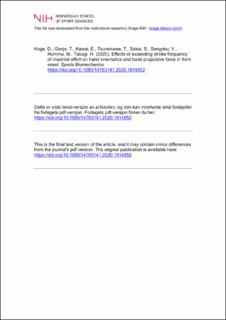| dc.contributor.author | Koga, Daiki | |
| dc.contributor.author | Gonjo, Tomohiro | |
| dc.contributor.author | Kawai, Eisuke | |
| dc.contributor.author | Tsunokawa, Takaaki | |
| dc.contributor.author | Sakai, Shin | |
| dc.contributor.author | Sengoku, Yasuo | |
| dc.contributor.author | Homma, Miwako | |
| dc.contributor.author | Takagi, Hideki | |
| dc.date.accessioned | 2021-09-01T12:38:32Z | |
| dc.date.available | 2021-09-01T12:38:32Z | |
| dc.date.created | 2020-10-05T15:43:32Z | |
| dc.date.issued | 2020 | |
| dc.identifier.citation | Sports Biomechanics. 2020, under utgivelse. | en_US |
| dc.identifier.issn | 1476-3141 | |
| dc.identifier.uri | https://hdl.handle.net/11250/2772274 | |
| dc.description | Dette er siste tekst-versjon av artikkelen, og den kan inneholde små forskjeller fra forlagets pdf-versjon. Forlagets pdf-versjon finner du her: https://doi.org/10.1080/14763141.2020.1814852 / This is the final text version of the article, and it may contain minor differences from the journal's pdf version. The original publication is available here: https://doi.org/10.1080/14763141.2020.1814852 | en_US |
| dc.description.abstract | This study aimed to assess kinematic and kinetic changes in front crawl with various stroke frequency (SF) conditions to investigate why swimming velocity (SV) does not increase above a certain SF (SFmax). Eight male swimmers performed 20 m front crawl four times. The first trial involved maximal effort, whereas SF was controlled during the next three trials. The instructed SFs were 100 (T100%), 110 (T110%), and 120% (T120%) of the SFmax. Through pressure measurement and underwater motion analysis, hand propulsive force (calculated by the difference between the palm and dorsal pressure value and the hand area) and the angle of attack of the hand were quantified, and differences between trials were assessed by a repeated-measures ANOVA. There was no difference in SV between the conditions, while the angle of attack during the latter half of the underwater stroke at T120% was smaller by 25.7% compared with T100% (p = 0.007). The lower angle of attack induced a lower pressure value on the palm that consequently caused a smaller hand propulsive force at T120% than T100% (p = 0.026). Therefore, the decrease in the angle of attack must be minimised to maintain the hand propulsive force. | en_US |
| dc.language.iso | eng | en_US |
| dc.subject | swimming velocity | en_US |
| dc.subject | fluid dynamics | en_US |
| dc.subject | motion analysis | en_US |
| dc.subject | motor | en_US |
| dc.subject | angle of attack | en_US |
| dc.title | Effects of exceeding stroke frequency of maximal effort on hand kinematics and hand propulsive force in front crawl | en_US |
| dc.type | Peer reviewed | en_US |
| dc.type | Journal article | en_US |
| dc.description.version | acceptedVersion | en_US |
| dc.source.pagenumber | 13 | en_US |
| dc.source.journal | Sports Biomechanics | en_US |
| dc.identifier.doi | 10.1080/14763141.2020.1814852 | |
| dc.identifier.cristin | 1837212 | |
| dc.description.localcode | Institutt for fysisk prestasjonsevne / Department of Physical Performance | en_US |
| cristin.ispublished | true | |
| cristin.fulltext | postprint | |
| cristin.qualitycode | 1 | |
